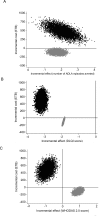Cost-effectiveness and social outcomes of a community-based treatment for podoconiosis lymphoedema in the East Gojjam zone, Ethiopia
- PMID: 31644556
- PMCID: PMC6808421
- DOI: 10.1371/journal.pntd.0007780
Cost-effectiveness and social outcomes of a community-based treatment for podoconiosis lymphoedema in the East Gojjam zone, Ethiopia
Abstract
Background: Podoconiosis is a disease of the lymphatic vessels of the lower extremities that is caused by chronic exposure to irritant soils. It results in leg swelling, commonly complicated by acute dermatolymphangioadenitis (ADLA), characterised by severe pain, fever and disability.
Methods: We conducted cost-effectiveness and social outcome analyses of a pragmatic, randomised controlled trial of a hygiene and foot-care intervention for people with podoconiosis in the East Gojjam zone of northern Ethiopia. Participants were allocated to the immediate intervention group or the delayed intervention group (control). The 12-month intervention included training in foot hygiene, skin care, bandaging, exercises, and use of socks and shoes, and was supported by lay community assistants. The cost-effectiveness analysis was conducted using the cost of productivity loss due to acute dermatolymphangioadenitis. Household costs were not included. Health outcomes in the cost-effectiveness analysis were: the incidence of ADLA episodes, health-related quality of life captured using the Dermatology Life Quality Index (DLQI), and disability scores measured using the WHO Disability Assessment Schedule 2.0 (WHODAS 2.0).
Results: The cost of the foot hygiene and lymphoedema management supplies was 529 ETB (69 I$, international dollars) per person per year. The cost of delivery of the intervention as part of the trial, including transportation, storage, training of lay community assistants and administering the intervention was 1,890 ETB (246 I$) per person. The intervention was effective in reducing the incidence of acute dermatolymphangioadenitis episodes and improving DLQI scores, while there were no significant improvements in the disability scores measured using WHODAS 2.0. In 75% of estimations, the intervention was less costly than the control. This was due to improved work productivity. Subgroup analyses based on income group showed that the intervention was cost-effective (both less costly and more effective) in reducing the number of acute dermatolymphangioadenitis episodes and improving health-related quality of life in families with monthly income <1,000 ETB (130 I$). For the subgroup with family income ≥1,000 ETB, the intervention was more effective but more costly than the control.
Conclusions: Whilst there is evident benefit of the intervention for all, the economic impact would be greatest for the poorest.
Conflict of interest statement
The authors have declared that no competing interests exist.
Figures


References
Publication types
MeSH terms
Grants and funding
LinkOut - more resources
Full Text Sources
Medical

